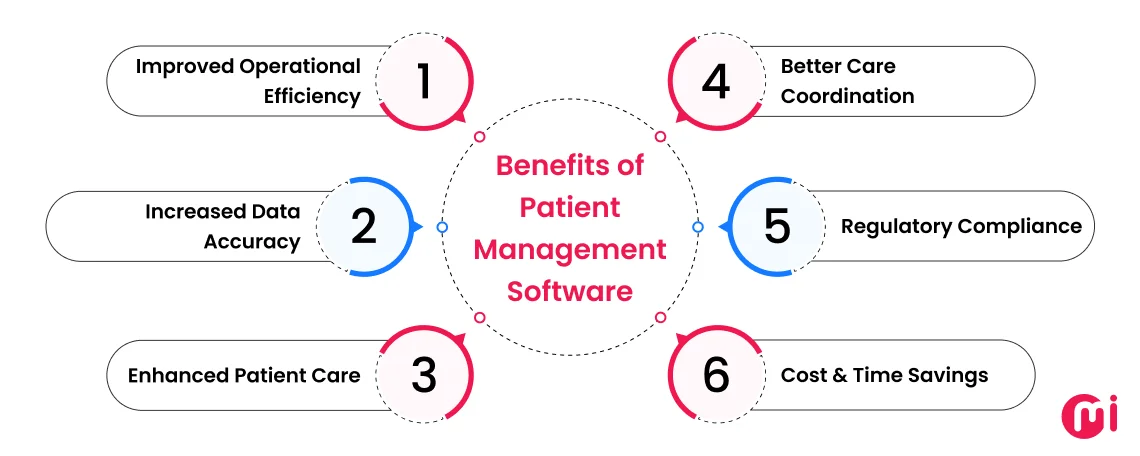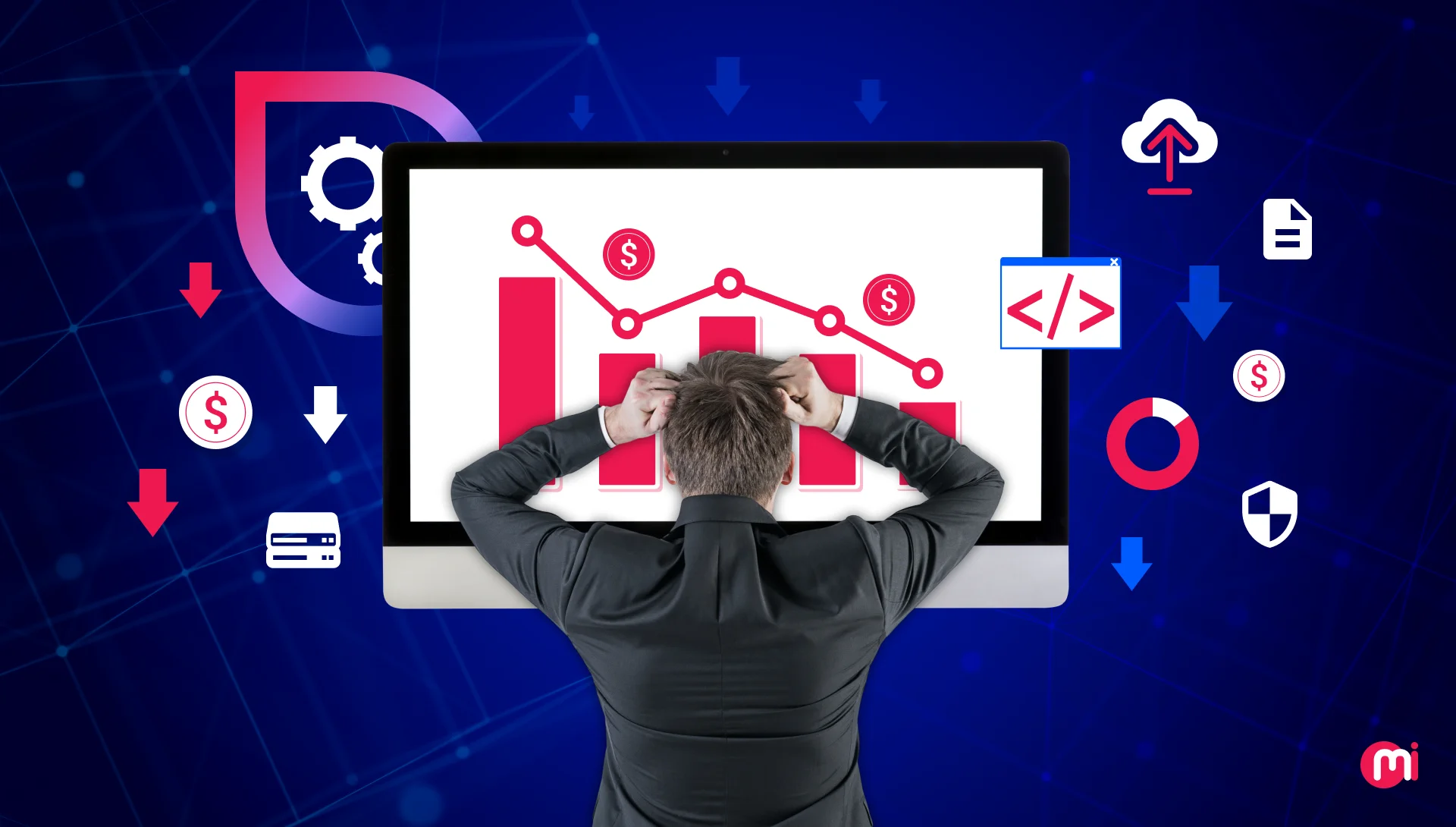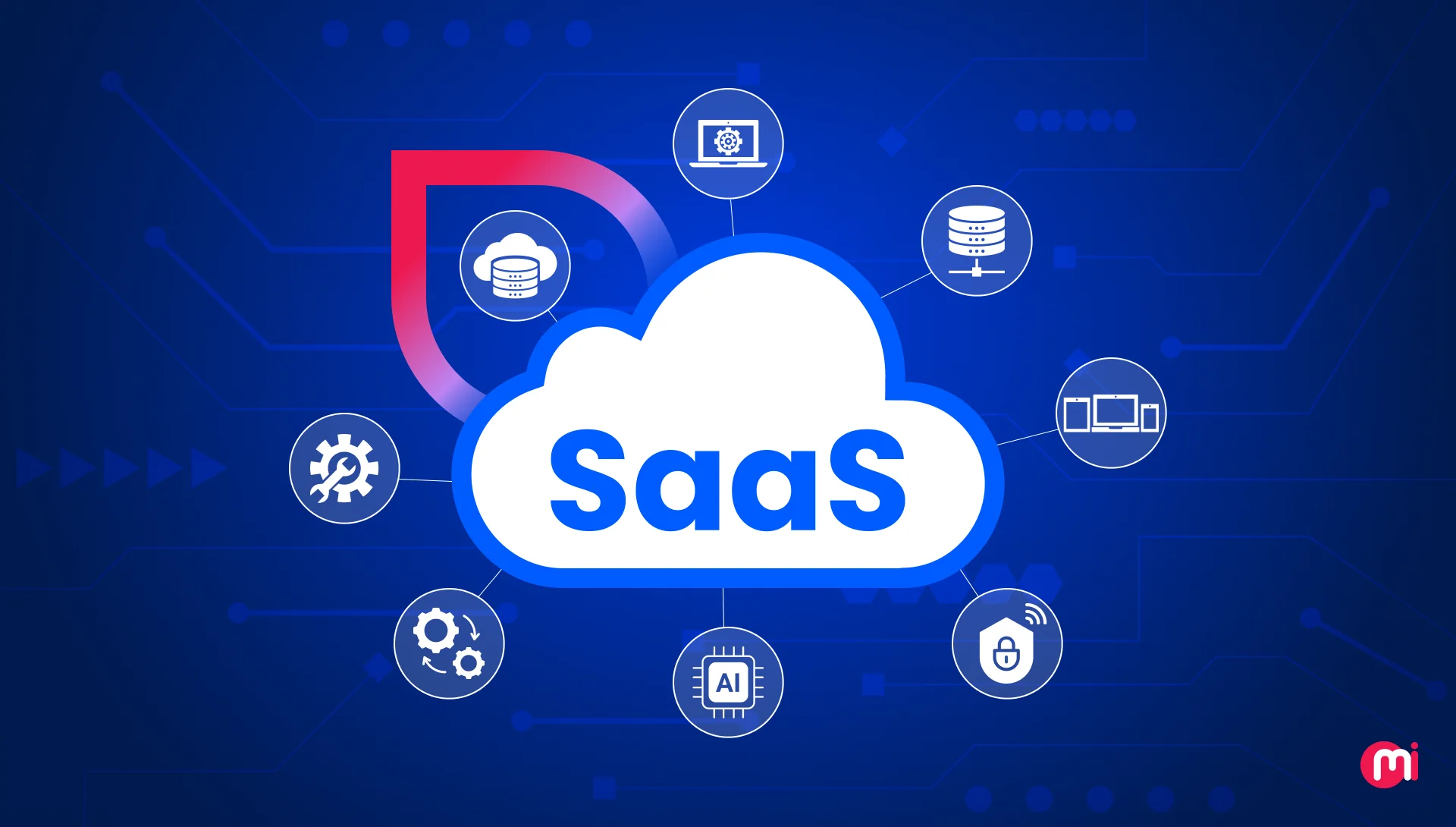How to Develop Patient Management Software for Hospitals and Clinics
- Software
- November 20, 2025
The healthcare industry is rapidly evolving toward digitization, and at the heart of this transformation lies patient management software (PMS). Right from managing appointments to maintaining electronic health records (EHRs), patient management systems streamline clinical workflows and improve the quality of patient care.
For hospitals, clinics, and healthcare startups alike, patient management software solutions, such as SimplePractice, DrChrono, and AdvancedMD, significantly reduce administrative burdens, minimize human error, and ensure compliance with healthcare data privacy regulations, including HIPAA and GDPR.

This blog explores everything you need to know about how to build a patient management software, including benefits, features, development process, cost, and future trends. If you’re a healthcare provider, this knowledge beforehand will help you know everything and choose the right healthcare software development company to build a PMS tailored to your organization’s needs.
Key Takeaways
- Patient Management Software (PMS) centralizes patient data, appointment scheduling, billing, and communication to streamline daily healthcare operations.
- Building an effective PMS requires strategic planning, compliance with HIPAA/FHIR standards, and user-focused design for seamless adoption.
- The future of PMS lies in AI-driven analytics, IoT integration, and decentralized data networks enabling predictive and personalized care.
- Partnering with the right healthcare software development company ensures scalability, security, and long-term digital transformation success for your healthcare initiative.
What Is Patient Management Software?
Patient management software (PMS) is a comprehensive digital tool designed specifically to centralize, manage, and automate daily healthcare operations. It centralizes patient data, appointments, billing, and communications into a single, secure platform accessible to medical professionals.
A patient management system acts as a central hub for managing all the information relating to patients and helps healthcare service providers automate tasks, improve efficiency, and boost patient care. In digital patient care, PMS ensures that every patient interaction, from booking a consultation to follow-up care, happens efficiently and seamlessly.
Core Functions of a Patient Management Software Include:
- Appointment scheduling and reminders
- Patient registration and records
- Electronic health records (EHR) management
- Billing and invoicing
- Clinical documentation
- Communication and telemedicine integration
Key Features & Functionalities of a Patient Management System
A well-developed patient management system comes embedded with all the necessary features and functionalities and streamlines every touchpoint in the patient journey. See the table below to know the key features and functionalities of a high-performance patient management software:
1. Appointment Scheduling
The appointment scheduling feature in a patient management software ensures online booking, automated reminders, real-time availability displays, and waitlist management. It improves patient experience through convenient self-scheduling options.
2. Electronic Health Records (EHR)
EHR in a patient management system consolidates all patient data, for instance, diagnoses, treatment history, test results, and so on, ensuring quick access for clinicians, improving diagnostic accuracy.
3. Telimedicine Integration
A patient management system enabled by telemedicine integration allows virtual consultations, making healthcare more accessible while maintaining optimal patient care.
4. Billing & Invoicing
Patient management software includes a billing & invoicing feature that automates payment processing, insurance claims, and billing reconciliation to simplify processes and reduce administrative workload.
5. Data Management
The data management feature organizes and integrates patient data, sometimes collecting information from medical devices, to provide a comprehensive view of a patient’s health journey.
6. Clinical Documentation
Clinical documentation feature in patient management software refers to the digital creation, storage, and management of a patient’s medical history, treatment, and care within a digital system like an electronic health record (EHR).
7. Claim Management
Patient management software automates claims management to streamline claim & tracking, reducing errors and speeding up the reimbursement process.
8. Notification & Reminders
The notification & reminders feature in a patient management system ensures sending automated SMS, email, or app reminders for appointments, prescriptions, and test results. It promotes flawless patient care.
9. Patient Data Security
This feature makes a patient management software secure with encryption and access controls, ensuring patient data is protected and complies with healthcare regulations.
10. Reporting
The very feature in a patient management system provides insights into performance through reports on patient no-shows, professionals’ productivity, and revenue.
Benefits of Implementing a Patient Management Software
Implementing patient management software offers benefits like improved operational efficiency, increased data accuracy, enhanced patient care, cost & time savings, and more. It improves security, compliance, and provides invaluable data analytics for better decision-making, ensuring optimized patient care.

1. Improved Operational Efficiency
The patient management software helps businesses automate repetitive tasks like scheduling, billing, and data entry, thereby minimizing administrative workload. With a PMS, healthcare staff are more likely to focus on patient care and less on paperwork, which results in smoother operations, faster turnaround times, and improved overall productivity.
2. Increased Data Accuracy
A digital patient management software ensures consistent, accurate, and up-to-date patient data across all departments. It helps clinicians make informed decisions while maintaining data integrity and compliance. This data accuracy increases operational efficiency, while fostering cost savings, and enhancing patient engagement through reliable and protected records.
3. Enhanced Patient Care
A PMS empowers patients with digital convenience, from booking appointments online to accessing medical records and communicating with healthcare providers anytime. A well-designed patient management software enhances patient care, reduces waiting times, and fosters a better relationship between the healthcare service provider and the patient through seamless, personalized interactions.
4. Better Care Coordination
A centralized patient database in a patient management software fosters real-time collaboration among physicians, nurses, and specialists. By sharing accurate, synchronized information, healthcare teams can make quicker decisions and ensure patients receive consistent, coordinated treatment across departments or facilities.
5. Regulatory Compliance
A patient management software helps healthcare organizations adhere to strict data protection standards such as HIPAA and GDPR by implementing access controls, encryption, and audit trails. It helps them reduce risks of breaches and penalties.
6. Cost & Time Savings
A PMS automates processes like billing, reporting, and scheduling, and thereby saves valuable time and resources. What’s more, the software reduces overhead costs, prevents redundancies, and streamlines workflows, allowing healthcare facilities to deliver higher-quality care with optimal efficiency.
How to Build a Patient Management Software
To build a patient management system, defining requirements & data architecture, choosing a tech stack, developing core features like patient records and scheduling, and then testing, deploying, and training staff are the sequential steps.
Furthermore, ensuring security and compliance are paramount throughout the process, requiring careful planning for data privacy, encryption, and user roles. Here’s all about how to build a PMS:
Step 1: Research & Plan Your Software Goals
Get started on patient management software development with a clear understanding of the users’ needs who will use the system. These users are likely to be doctors, nurses, administrative staff, and patients. Intensive research and planning based on this data helps you develop software with all the essential features that address the challenges users face daily.
Conduct:
- Market research to evaluate competitors, such as DrChrono and AdvancedMD.
- Compliance analysis to ensure adherence to regulations like HIPAA, HL7, and FHIR
- Stakeholder interviews to help you define workflows and priorities
The outcome of this phase should be a product requirement document (PRD) that outlines goals, features, and user personas. It’ll help healthcare providers know exactly what is needed for flawless patient management and build a solution that completely guarantees it.
Step 2: Define Clear System Requirements
Now that you’re clear about the requirements, define the software requirements clearly. Different healthcare facilities have unique operational workflows, and so should yours.
Therefore, before moving to the development phase, define what features and functionalities your patient management software needs. It may involve:
- Functional requirements: Appointment booking, billing, notifications, reporting tools, and EHR/EMR integration
- Non-functional requirements: Performance, scalability, security, and data encryption
What’s more, also focus on deciding on the deployment model of the product, like on-premise, cloud-based, or hybrid, depending on data control preferences and scalability goals.
Step 3: Design the System Architecture and UI/UX
Design the system architecture and UI/UX excellently, as it’s crucial and defines whether your patient management system becomes a valuable asset or an expensive burden. Create the system architecture that outlines how databases, APIs, and modules communicate.
UI/UX should be appealing enough to gain traction in the very beginning of the product launch. A user-centered design is crucial for a seamless adoption. You can leverage the best UI/UX design services for this venture.
Create wireframes & prototypes to visualize the interface before development begins. Ensure creating UX workflows that help you ensure simplicity for medical staff with minimal training required.
Healthcare professionals value intuitive, clutter-free dashboards, so it’s essential for software to ensure accessibility, mobile responsiveness, and clear navigation to succeed.
Step 4: Develop the Patient Management Software
Once the design and architecture are approved, development begins. The recommended tech stack to build a patient management software includes:
- Frontend: React, Angular, or Vue
- Backend: Node.js, Django, .NET Core
- Database: PostgreSQL, MySQL, MongoDB
- Cloud: AWS, Azure, or Google Cloud
- Security: OAuth 2.0, SSL/TLS, AES encryption
If you’re a healthcare provider, choose the right software development partner that excels at building high-end products. Leverage their help, develop modules iteratively using Agile methodology, allowing continuous feedback and flexibility.
Focus on integrations, EHRs, telemedicine platforms, laboratory APIs, and insurance systems, using healthcare data standards like FHIR or HL7.
Step 5: Test and Assure Software Quality
After the development, testing ensures the software is secure, reliable, and compliant before launch. Here are the types QAs consider when testing the software:
Testing Types:
- Unit & Integration Testing: Validate each feature and data flow
- Security Testing: Identify vulnerabilities and ensure encryption and access controls are robust
- Usability Testing: Involve doctors and administrative staff in testing for user experience feedback
- Compliance Testing: Verify adherence to HIPAA, GDPR, and other local regulations
Step 6: Deploy, Monitor, and Maintain the System
Once tested, deployment of the patient management software takes place. This phase involves deploying the software on secure servers or cloud environments. After deployment, ongoing maintenance is vital, which includes monitoring performance, patching security vulnerabilities, and rolling out updates when needed.
Organizations provide appropriate training sessions for healthcare staff to encourage adoption and reduce resistance to digital transformation. It fosters a smooth onboarding of the patient management system to the healthcare ecosystem.
Top Examples of Patient Management Software
SimplePractice, DrChrono, and AdvancedMD are all top patient management software examples, with additional electronic health record (EHR) and billing capabilities. They offer features like appointment scheduling, patient management, and billing; however, they can also handle electronic medical records, patient portals, and other administrative tasks.
SimplePractice
It’s a leading patient management system designed for small clinics, therapists, and healthcare professionals. SimplePractice offers online booking, client records, billing, telehealth, and secure messaging, all in one easy-to-use platform.
This software is often recognized for being user-friendly and affordable, making it popular with solo practitioners and small clinics.
DrChrono
DrChrono is a cloud-based EHR and patient management system that integrates appointment scheduling, billing, and patient engagement tools. It’s ideal for medical institutions of all sizes and supports mobile access through iPad and iPhone apps, enhancing flexibility and efficiency.
DrChrono is an all-in-one solution that combines EHR, practice management, and billing, and is well-known for its mobile-first design.
AdvancedMD
AdvancedMD is an integrated practice management and EHR solution tailored for medium to large medical organizations. It includes workflow automation, patient portals, claims management, real-time analytics to optimize efficiency, and advanced administrative and billing functions.
This is a comprehensive and integrated patient management software solution that is often best for medium to large organizations.
How Much Does It Cost to Build Patient Management Software?
The cost to build custom patient management software varies widely, generally ranging from $30,000 to $300,000 for a mid-range system, and potentially exceeding $1 million for complex enterprise solutions. Pre-built or basic systems can be less expensive, starting from a few thousand dollars. Look at the table below to know the estimated cost of a patient management software development:
Estimated Patient Management Software Development Cost by Project Complexity
| Complexity | Estimated Development Cost | Estimated Timeline |
| Basic (MVP/Small Clinic) | $30,000 – $100,000 | 3-6 months |
| Mid-Range (Mid-sized Hospital, more features) | $30,000 – $300,000 | 4-12 months |
| Advanced (Enterprise, AI, IoT, extensive features) | $150,000 – $500,000+ | 9+ months |
Challenges & Best Practices for Patient Management Software Development
Developing patient management software comes with unique challenges, like managing sensitive health data, interoperability & data exchange standards, ensuring scalability & performance, and more.
However, there are best practices following which organizations can ensure flawless software development for patient management. Here’s how to address them effectively:
| Challenges of PMS Development | Best Practices for PMS Development |
| Managing Sensitive Health Data Securely | Implementing end-to-end encryption, role-based access control, and regular security audits. Always complying with HIPAA, GDPR, and local data protection laws |
| Interoperability and Data Exchange Standards (FHIR, HL7) | Adopting healthcare standards to enable seamless data sharing between hospitals, labs, and insurance systems |
| Ensuring Scalability and Performance | Building on a cloud-based architecture that supports high concurrency, real-time updates, and fast response times |
| Continuous Compliance Monitoring | Regulations evolve, hence, setting up automated monitoring and auditing systems to ensure ongoing compliance |
| Training Staff for Smooth Adoption | Offering onboarding sessions, training materials, and responsive technical support to encourage smooth adoption |
Future Trends in Patient Management Software
Future trends in patient management systems focus on predictive & generative AI and automation, telemedicine and remote monitoring, and a shift toward more patient-centric, interoperable solutions. Here’s how:
Predictive and Generative AI for Proactive Care
While AI in healthcare is already being integrated with PMS for scheduling and analytics, the future will focus on predictive insights and using generative AI in healthcare. The Gen AI-enabled tools will analyze patient data to forecast health risks, personalize treatment plans, and even assist in clinical documentation and diagnosis recommendations, driving truly data-driven healthcare.
Blockchain 2.0 and Decentralized Health Data Networks
Blockchain’s future in patient management systems goes beyond secure data storage. Emerging decentralized data-sharing ecosystems will allow patients to own and control their health data, granting access to providers or researchers on demand. This evolution will redefine data transparency, interoperability, and consent management.
Virtual Assistants and Chatbots for Patient Engagement
There are many use cases and examples of AI in healthcare, and chatbots are one of them. Chatbots today handle basic queries, but next-gen AI-powered virtual assistants will go further, monitoring vitals, scheduling follow-ups, offering medication reminders, and providing emotional support through natural conversation. These systems will act as continuous companions in patient engagement and chronic care management.
Advanced Wearable & IoT Integration
The role of AI and ML in healthcare is already transformative, but its impact will grow even stronger as it converges with wearable and IoT technologies. Future patient management systems will leverage AI-powered analytics to interpret continuous real-time data from connected devices, from heart rate monitors to smartwatches.
This integration will enable predictive diagnostics, early intervention, and personalized health recommendations, creating a connected and preventive healthcare ecosystem rather than a reactive one.

MindInventory Builds PMS that Streamlines Care & Simplifies Workflows
Attributed to its features and benefits, the patient management software is no longer optional, but a strategic necessity for modern healthcare providers. At MindInventory, we understand how crucial it is for healthcare providers to have tailor-made patient management software and help you build one that meets your needs.
Leveraging 14+ years of experience, we’ve delivered 2500+ projects successfully in more than 40+ countries, and excel at software development for the healthcare industry. Be it building a new patient management software, modernizing an existing one, or just a quick consultation session with our experts for clarity on the idea, we can do it all for you.
We help you hire software developers excelling in developing software for healthcare, so that you can build one for your organization with ease.
See how we developed a scalable patient management system to help one of our clients streamline their patient management. The client experienced:
- Better Data Accuracy
- Optimized Regulatory Compliance for Startup Success
- Cloud-Based Scalability for Rapid Growth
- Seamless Integration with Third-Party Systems
- Real-Time Analytics for Data-Driven Decisions
Whether you’re upgrading an existing system or developing one from scratch, partnering with a reliable healthcare software development company ensures your PMS is secure, compliant, and future-ready.
FAQs on Patient Management Software Development
SimplePractice, DrChrono, and AdvancedMD are among the most widely used patient management systems, offering EHR and patient management capabilities for hospitals and clinics.
EHR focuses on clinical data and patient history, while PMS manages broader administrative workflows such as scheduling, billing, and patient communication.
Common technologies include React or Angular (frontend), Node.js or .NET (backend), PostgreSQL or MongoDB (database), and AWS or Azure for cloud deployment.
The patient data in a patient management system software can be secured through encryption, multi-factor authentication, role-based access, and compliance with HIPAA or GDPR standards.
Yes. PMS integrates easily with EHRs, laboratory systems, insurance APIs, and telehealth platforms following HL7 or FHIR standards.
AI helps automate reminders, analyze patient data for early risk detection, and personalize care plans.
Buying offers quick deployment but limited flexibility. Building custom patient management software allows full customization, scalability, and better long-term ROI.
Key compliance to meet for a PMS includes HIPAA (US), GDPR (EU), PIPEDA (Canada), and interoperability standards like HL7 and FHIR.
On average, patient management software development takes 3–4 months for an MVP and 9–12 months for a fully featured enterprise-grade solution. The time may expand a bit depending on the project complexity, feature & functionality, and so on.













